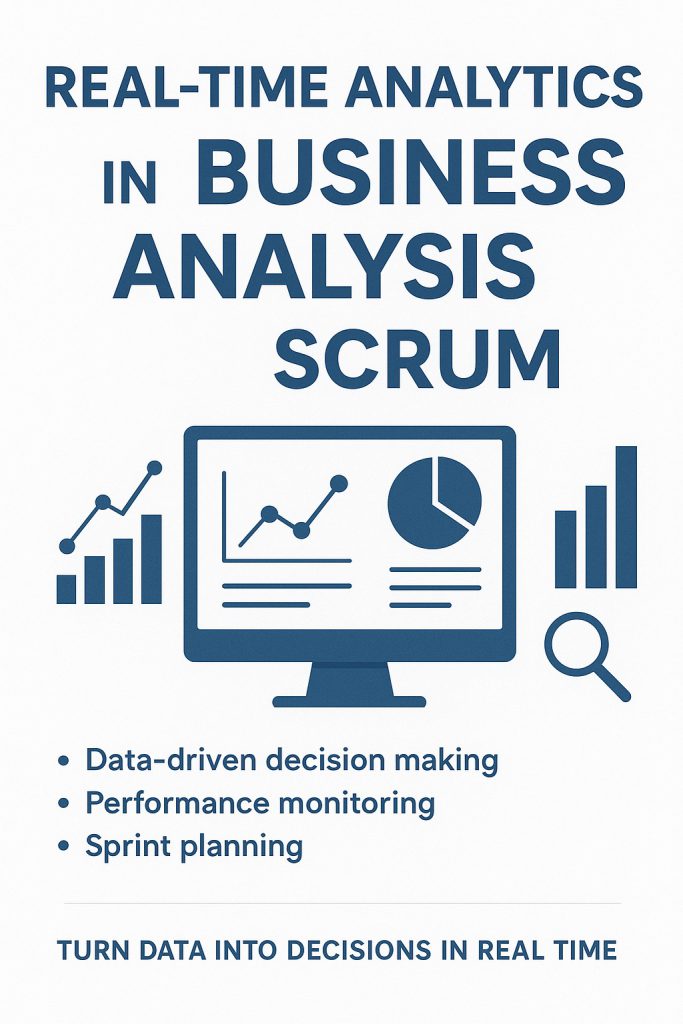In today’s fast-paced business environment, waiting weeks or months for performance reports is no longer enough. Customers expect rapid responses, markets change overnight, and competitors are constantly innovating. This reality is pushing organizations to adopt real-time analytics as a critical tool in business analysis (BA) and Scrum practices.
When used effectively, real-time analytics can transform the way teams make decisions, prioritize work, and deliver value. Instead of relying solely on historical data, Scrum teams and business analysts can access live insights, identify trends as they emerge, and adjust their strategies accordingly.
But how exactly does this integration work, and why does it matter so much today?
The Role of Real-Time Analytics in Business Analysis
Business analysis has always been about bridging the gap between business needs and technical solutions. Traditionally, business analysts relied on requirement documents, stakeholder interviews, and periodic performance reviews. While useful, these methods often produced insights that were reactive rather than proactive.
With real-time analytics, business analysts gain the ability to:
Track user behavior instantly – For example, monitoring customer interactions with a new app feature as soon as it goes live.
Spot inefficiencies quickly – Identifying bottlenecks in workflows or processes in real-time instead of discovering them months later.
Support data-driven decisions – Shifting conversations with stakeholders from gut feelings to evidence-based insights.
This empowers analysts to refine requirements, validate assumptions, and ensure that the product backlog in Scrum is aligned with current business realities, not outdated data.
How Real-Time Analytics Enhances Scrum
Scrum is built around short, iterative cycles called sprints. Teams aim to deliver increments of value while inspecting and adapting along the way. However, one of the biggest challenges Scrum teams face is knowing whether they are building the right things at the right time.
This is where real-time analytics in Scrum becomes a game-changer.
Improved Sprint Planning
Real-time usage data and feedback can help Product Owners prioritize backlog items based on actual customer behavior, not assumptions. If analytics show a sudden spike in demand for a feature, it can move higher up the backlog.
Smarter Daily Scrums
Teams can use analytics dashboards to quickly identify blockers or performance dips, making daily scrums more focused on solutions rather than guesswork.
Data-Driven Reviews and Retrospectives
Sprint reviews are more impactful when teams can showcase live data demonstrating how features are performing. Retrospectives become sharper when analytics highlight trends in velocity, quality, or customer engagement.
Early Risk Identification
Real-time monitoring helps detect anomalies—like a drop in user adoption or system performance—before they grow into bigger issues. This aligns perfectly with Scrum’s principle of continuous inspection and adaptation.
Benefits of Real-Time Analytics for Agile Teams
By embedding real-time analytics into BA and Scrum practices, organizations unlock:
Faster feedback loops – Shortening the time between delivery and learning.
Increased agility – Teams pivot quickly based on data, not assumptions.
Higher customer satisfaction – Products evolve in line with actual usage patterns.
Reduced waste – Features that don’t perform as expected are adjusted or dropped sooner.
In essence, real-time analytics turns Scrum into a more evidence-based framework, ensuring every sprint contributes meaningfully to business outcomes.
Challenges to Watch Out For
Of course, adopting real-time analytics isn’t without challenges:
Information overload – Teams must learn to focus on metrics that matter most, not just vanity metrics.
Integration with existing tools – Ensuring analytics platforms work smoothly with Scrum boards and BA systems.
Skill gaps – Business analysts and Scrum Masters may need training to interpret complex data.
The key is to start small—focusing on a handful of actionable metrics—and scale gradually.
Conclusion: The Future of BA and Scrum is Data-Driven
Real-time analytics is no longer a luxury; it is a necessity. Business analysts and Scrum teams that embrace it are better equipped to stay ahead of customer expectations, deliver business value, and maintain a competitive edge.
As agile frameworks continue to evolve, the ability to analyze and act on live data will separate teams that merely deliver features from those that deliver true outcomes.
If you are a business analyst, Scrum Master, or product leader, the time to embrace real-time analytics is now. It’s the bridge between agility and impact—the very thing that can elevate your team’s performance to the next level.
👉 Ready to take your skills to the next level?
Enroll today and transform your career with ScrumConsult’s professional training programs. From Scrum Master Certification in Lagos to Agile Expert, Project Management, Business Analysis, Lean Six-Sigma Green & Black Belt, SMC, PSM, and CSM, we provide the tools and knowledge you need to thrive in a data-driven world.
📌 Visit scrumconsult.com today to get started

